
RLinf
RLinf is a flexible and scalable open-source infrastructure designed for post-training foundation models (LLMs, VLMs, VLAs) via reinforcement learning.
Stars: 450
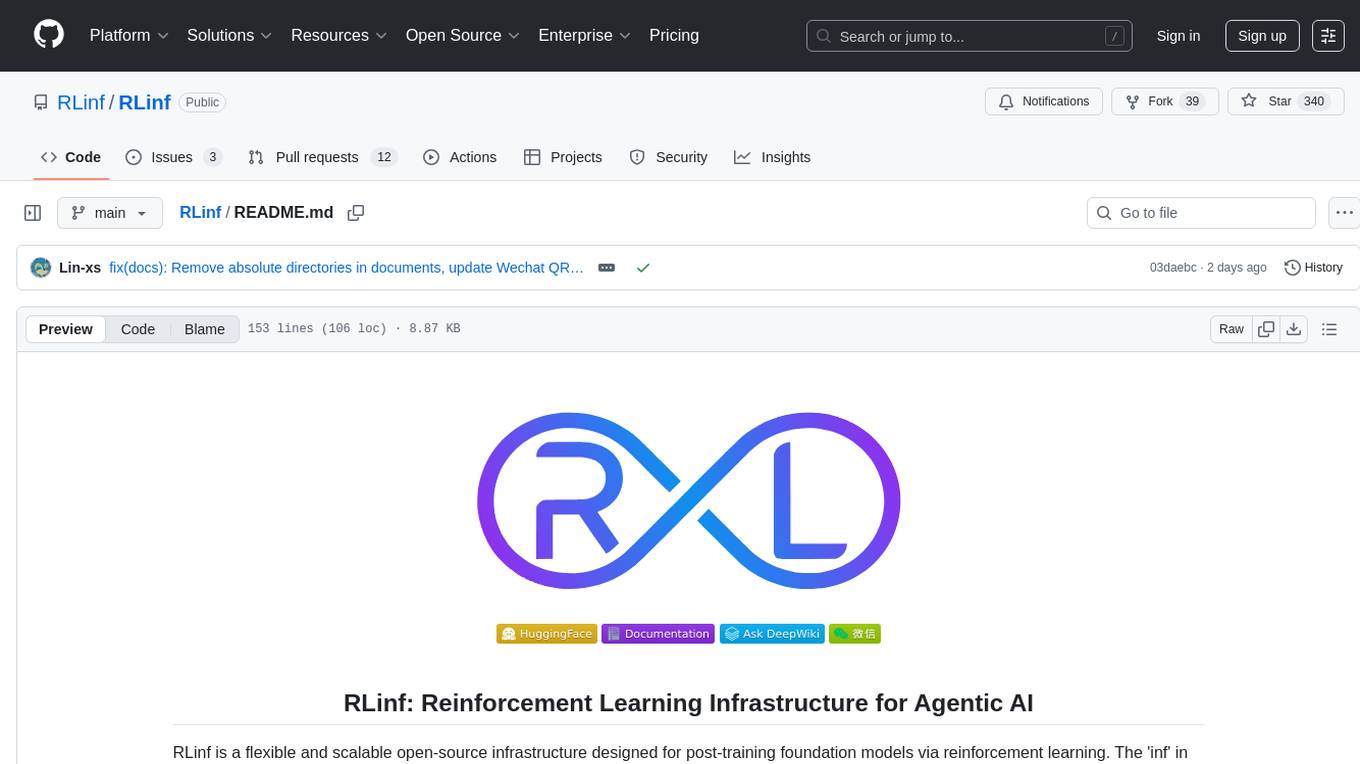
RLinf is a flexible and scalable open-source infrastructure designed for post-training foundation models via reinforcement learning. It provides a robust backbone for next-generation training, supporting open-ended learning, continuous generalization, and limitless possibilities in intelligence development. The tool offers unique features like Macro-to-Micro Flow, flexible execution modes, auto-scheduling strategy, embodied agent support, and fast adaptation for mainstream VLA models. RLinf is fast with hybrid mode and automatic online scaling strategy, achieving significant throughput improvement and efficiency. It is also flexible and easy to use with multiple backend integrations, adaptive communication, and built-in support for popular RL methods. The roadmap includes system-level enhancements and application-level extensions to support various training scenarios and models. Users can get started with complete documentation, quickstart guides, key design principles, example gallery, advanced features, and guidelines for extending the framework. Contributions are welcome, and users are encouraged to cite the GitHub repository and acknowledge the broader open-source community.
README:
RLinf is a flexible and scalable open-source infrastructure designed for post-training foundation models via reinforcement learning. The 'inf' in RLinf stands for Infrastructure, highlighting its role as a robust backbone for next-generation training. It also stands for Infinite, symbolizing the system’s support for open-ended learning, continuous generalization, and limitless possibilities in intelligence development.
- [2025/09]
Example Gallery is updated, users can find various off-the-shelf examples!
- [2025/09] The paper RLinf: Flexible and Efficient Large-scale Reinforcement Learning via Macro-to-Micro Flow Transformation is released.
- [2025/08] RLinf is open-sourced. The formal v0.1 will be released soon.
RLinf is unique with:
-
Macro-to-Micro Flow: a new paradigm M2Flow, which executes macro-level logical flows through micro-level execution flows, decoupling logical workflow construction (programmable) from physical communication and scheduling (efficiency).
-
Flexible Execution Modes
- Collocated mode: shares all GPUs across all workers.
- Disaggregated mode: enables fine-grained pipelining.
- Hybrid mode: a customizable combination of different placement modes, integrating both collocated and disaggregated modes.
-
Auto-scheduling Strategy: automatically selects the most suitable execution mode based on the training workload, without the need for manual resource allocation.
-
Embodied Agent Support
- Fast adaptation support for mainstream VLA models: OpenVLA, OpenVLA-OFT, π₀ and π₀.₅.
- Support for mainstream CPU & GPU-based simulators via standardized RL interfaces: ManiSkill3, LIBERO.
- Enabling the first RL fine-tuning of the $\pi_0$ and $\pi_{0.5}$ model family with a flow-matching action expert.
RLinf is fast with:
- Hybrid mode with fine-grained pipelining: achieves a 120%+ throughput improvement compared to other frameworks.
- Automatic Online Scaling Strategy: dynamically scales training resources, with GPU switching completed within seconds, further improving efficiency by 20–40% while preserving the on-policy nature of RL algorithms.
RLinf is flexible and easy to use with:
-
Multiple Backend Integrations
- FSDP + Hugging Face: rapid adaptation to new models and algorithms, ideal for beginners and fast prototyping.
- Megatron + SGLang: optimized for large-scale training, delivering maximum efficiency for expert users with demanding workloads.
-
Adaptive communication via the asynchronous communication channel
-
Built-in support for popular RL methods, including PPO, GRPO, DAPO, Reinforce++, and more.
| OpenVLA-OFT model results on ManiSkill3 | ||||
|---|---|---|---|---|
| Model | Vision | Semantic | Position | Average |
| 76.6% | 75.4% | 77.6% | 76.1% | |
| 84.6% | 51.6% | 42.9% | 61.5% | |
| 80.5% | 56.6% | 56.1% | 64.5% | |
| 82.0% | 80.6% | 89.3% | 82.2% | |
| 74.7% | 74.4% | 81.6% | 75.5% | |
| OpenVLA-OFT model results on LIBERO | |||||
|---|---|---|---|---|---|
| Model | Spatial | Goal | Object | Long | Average |
| OpenVLA-OFT-SFT (one-shot) | 56.5% | 45.6% | 25.6% | 9.7% | 34.4% |
| OpenVLA-OFT-RLinf | 99.0% | 99.0% | 99.0% | 94.4% | 97.9% |
| Improvement | +42.5% | +53.4% | +73.4% | +84.7% | +63.5% |
- RLinf supports both PPO and GRPO algorithms, enabling state-of-the-art training for Vision-Language-Action models.
- The framework provides seamless integration with mainstream embodied intelligence benchmarks, including ManiSkill3 and LIBERO, and achieves strong performance across diverse evaluation metrics.
| 1.5B model results | ||||
|---|---|---|---|---|
| Model | AIME 24 | AIME 25 | GPQA-diamond | Average |
| 28.33 | 24.90 | 27.45 | 26.89 | |
| 37.80 | 30.42 | 32.11 | 33.44 | |
| 40.41 | 30.93 | 27.54 | 32.96 | |
| 40.73 | 31.56 | 28.10 | 33.46 | |
| AReaL-1.5B-retrain* | 44.42 | 34.27 | 33.81 | 37.50 |
| 43.65 | 32.49 | 35.00 | 37.05 | |
| 48.44 | 35.63 | 38.46 | 40.84 | |
* We retrain the model using the default settings for 600 steps.
| 7B model results | ||||
|---|---|---|---|---|
| Model | AIME 24 | AIME 25 | GPQA-diamond | Average |
| 54.90 | 40.20 | 45.48 | 46.86 | |
| 61.66 | 49.38 | 46.93 | 52.66 | |
| 66.87 | 52.49 | 44.43 | 54.60 | |
| 68.55 | 51.24 | 43.88 | 54.56 | |
| 67.30 | 55.00 | 45.57 | 55.96 | |
| 68.33 | 52.19 | 48.18 | 56.23 | |
- RLinf achieves state-of-the-art performance on math reasoning tasks, consistently outperforming existing models across multiple benchmarks (AIME 24, AIME 25, GPQA-diamond) for both 1.5B and 7B model sizes.
- [ ] Support for heterogeneous GPUs
- [ ] Support for asynchronous pipeline execution
- [ ] Support for Mixture of Experts (MoE)
- [ ] Support for vLLM inference backend
- [ ] Support for Vision-Language Models (VLMs) training
- [ ] Support for deep searcher agent training
- [ ] Support for multi-agent training
- [ ] Support for integration with more embodied simulators (e.g., Meta-World, GENESIS, RoboTwin)
- [ ] Support for more Vision Language Action models (VLAs), such as GR00T, WALL-OSS
- [ ] Support for world model
- [ ] Support for real-world RL embodied intelligence
Complete documentation for RLinf can be found Here.
Quickstart
- Installation
- Quickstart 1: PPO Training of VLAs on Maniskill3
- Quickstart 2: GRPO Training of LLMs on MATH
- Multi-node Training
- Model Evaluation
Key Design
- Unified User Interface Usage
- Flexible Execution Modes
- Enable Automatic Scheduling
- Elastic Communication
Example Gallery
Advanced Features
- 5D Parallelism Configuration for Megatron-LM
- LoRA Integration for efficient fine-tuning
- Switch between different versions of SGLang
- Checkpoint Resume and Recovery Support
Extending The Framework:
- Adding new Environments
- Adding new Models with FSDP+Huggingface backend
- Adding new Models with Megatron+SGLang backend
Blogs
| Type | Status |
|---|---|
| Reasoning RL-MATH | |
| Embodied RL-VLA |
We welcome contributions to RLinf. Please read contribution guide before taking action.
If you find RLinf helpful, please cite the paper:
@misc{yu2025rlinfflexibleefficientlargescale,
title={RLinf: Flexible and Efficient Large-scale Reinforcement Learning via Macro-to-Micro Flow Transformation},
author={Chao Yu and Yuanqing Wang and Zhen Guo and Hao Lin and Si Xu and Hongzhi Zang and Quanlu Zhang and Yongji Wu and Chunyang Zhu and Junhao Hu and Zixiao Huang and Mingjie Wei and Yuqing Xie and Ke Yang and Bo Dai and Zhexuan Xu and Xiangyuan Wang and Xu Fu and Zhihao Liu and Kang Chen and Weilin Liu and Gang Liu and Boxun Li and Jianlei Yang and Zhi Yang and Guohao Dai and Yu Wang},
year={2025},
eprint={2509.15965},
archivePrefix={arXiv},
primaryClass={cs.LG},
url={https://arxiv.org/abs/2509.15965},
}If you use RL+VLA in RLinf, you can also cite our empirical study paper:
@misc{liu2025rlbringvlageneralization,
title={What Can RL Bring to VLA Generalization? An Empirical Study},
author={Jijia Liu and Feng Gao and Bingwen Wei and Xinlei Chen and Qingmin Liao and Yi Wu and Chao Yu and Yu Wang},
year={2025},
eprint={2505.19789},
archivePrefix={arXiv},
primaryClass={cs.LG},
url={https://arxiv.org/abs/2505.19789},
}Acknowledgements RLinf has been inspired by, and benefits from, the ideas and tooling of the broader open-source community. In particular, we would like to thank the teams and contributors behind VeRL, AReaL, Megatron-LM, SGLang, and PyTorch Fully Sharded Data Parallel (FSDP), and if we have inadvertently missed your project or contribution, please open an issue or a pull request so we can properly credit you.
Contact: We welcome applications from Postdocs, PhD/Master's students, and interns. Join us in shaping the future of RL infrastructure and embodied AI!
- Chao Yu: [email protected]
- Yu Wang: [email protected]
For Tasks:
Click tags to check more tools for each tasksFor Jobs:
Alternative AI tools for RLinf
Similar Open Source Tools

RLinf
RLinf is a flexible and scalable open-source infrastructure designed for post-training foundation models via reinforcement learning. It provides a robust backbone for next-generation training, supporting open-ended learning, continuous generalization, and limitless possibilities in intelligence development. The tool offers unique features like Macro-to-Micro Flow, flexible execution modes, auto-scheduling strategy, embodied agent support, and fast adaptation for mainstream VLA models. RLinf is fast with hybrid mode and automatic online scaling strategy, achieving significant throughput improvement and efficiency. It is also flexible and easy to use with multiple backend integrations, adaptive communication, and built-in support for popular RL methods. The roadmap includes system-level enhancements and application-level extensions to support various training scenarios and models. Users can get started with complete documentation, quickstart guides, key design principles, example gallery, advanced features, and guidelines for extending the framework. Contributions are welcome, and users are encouraged to cite the GitHub repository and acknowledge the broader open-source community.
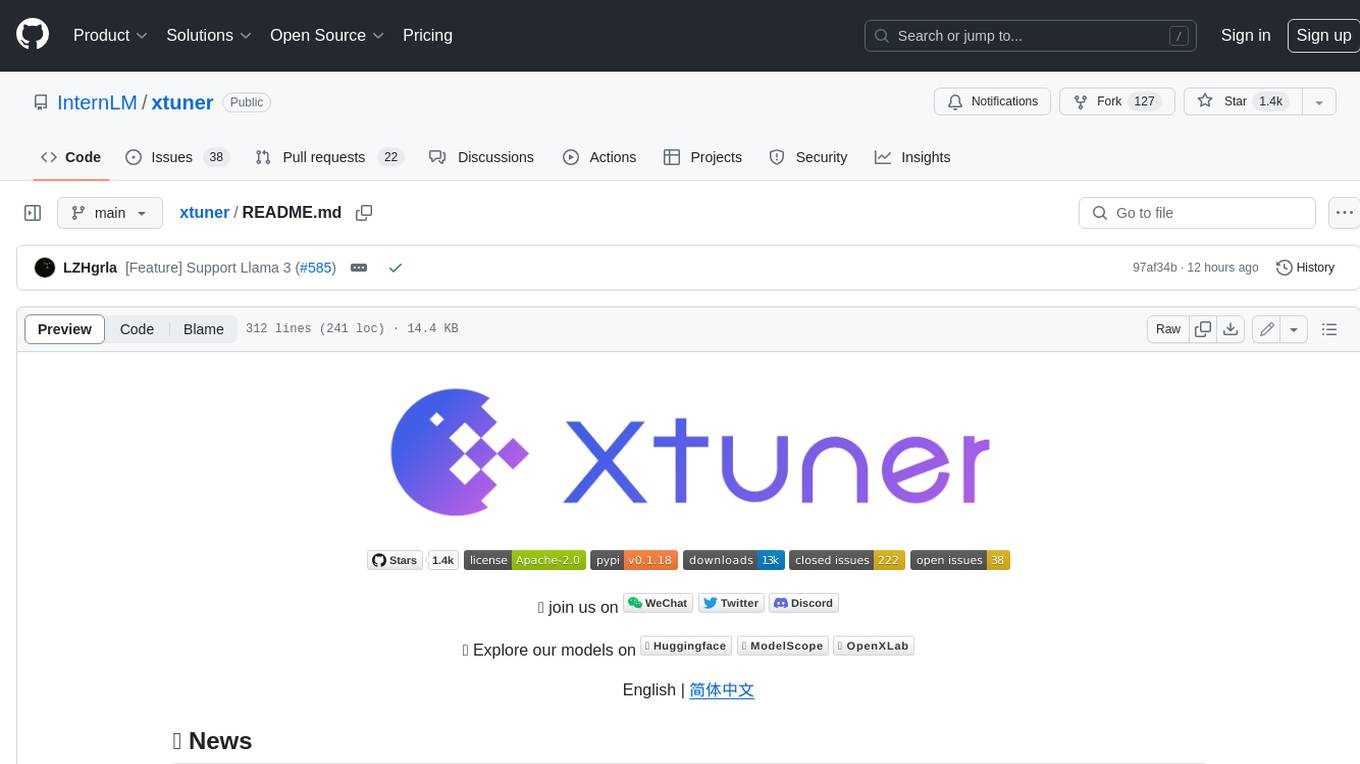
xtuner
XTuner is an efficient, flexible, and full-featured toolkit for fine-tuning large models. It supports various LLMs (InternLM, Mixtral-8x7B, Llama 2, ChatGLM, Qwen, Baichuan, ...), VLMs (LLaVA), and various training algorithms (QLoRA, LoRA, full-parameter fine-tune). XTuner also provides tools for chatting with pretrained / fine-tuned LLMs and deploying fine-tuned LLMs with any other framework, such as LMDeploy.
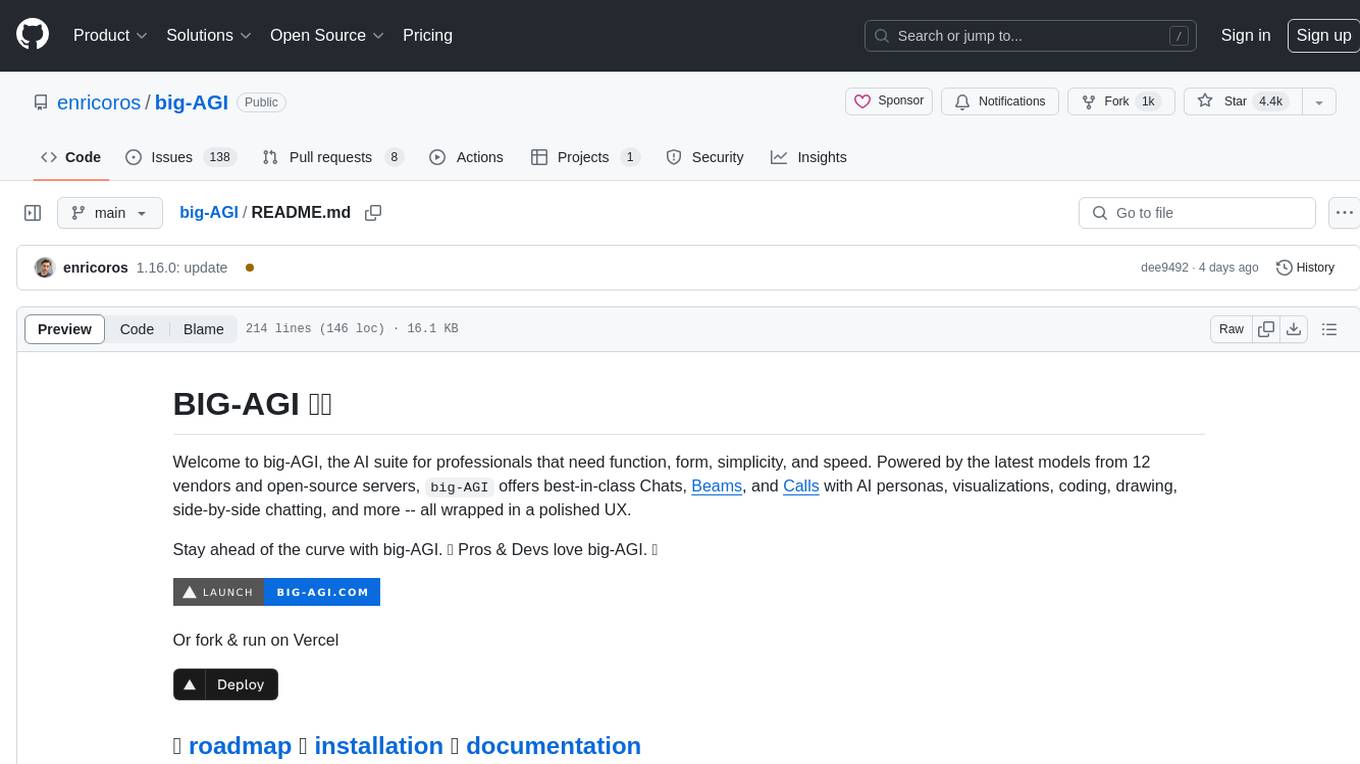
big-AGI
big-AGI is an AI suite designed for professionals seeking function, form, simplicity, and speed. It offers best-in-class Chats, Beams, and Calls with AI personas, visualizations, coding, drawing, side-by-side chatting, and more, all wrapped in a polished UX. The tool is powered by the latest models from 12 vendors and open-source servers, providing users with advanced AI capabilities and a seamless user experience. With continuous updates and enhancements, big-AGI aims to stay ahead of the curve in the AI landscape, catering to the needs of both developers and AI enthusiasts.
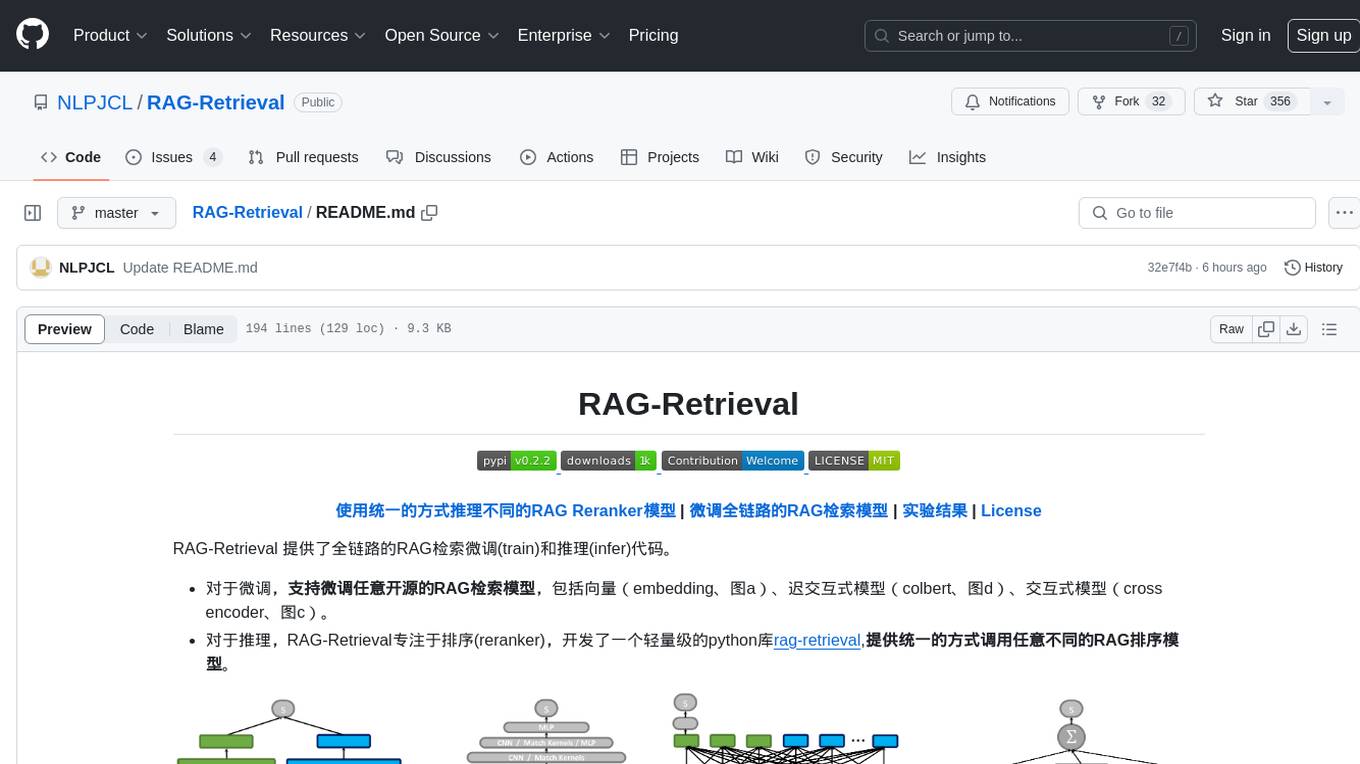
RAG-Retrieval
RAG-Retrieval provides full-chain RAG retrieval fine-tuning and inference code. It supports fine-tuning any open-source RAG retrieval models, including vector (embedding, graph a), delayed interactive models (ColBERT, graph d), interactive models (cross encoder, graph c). For inference, RAG-Retrieval focuses on ranking (reranker) and has developed a lightweight Python library rag-retrieval, providing a unified way to call any different RAG ranking models.
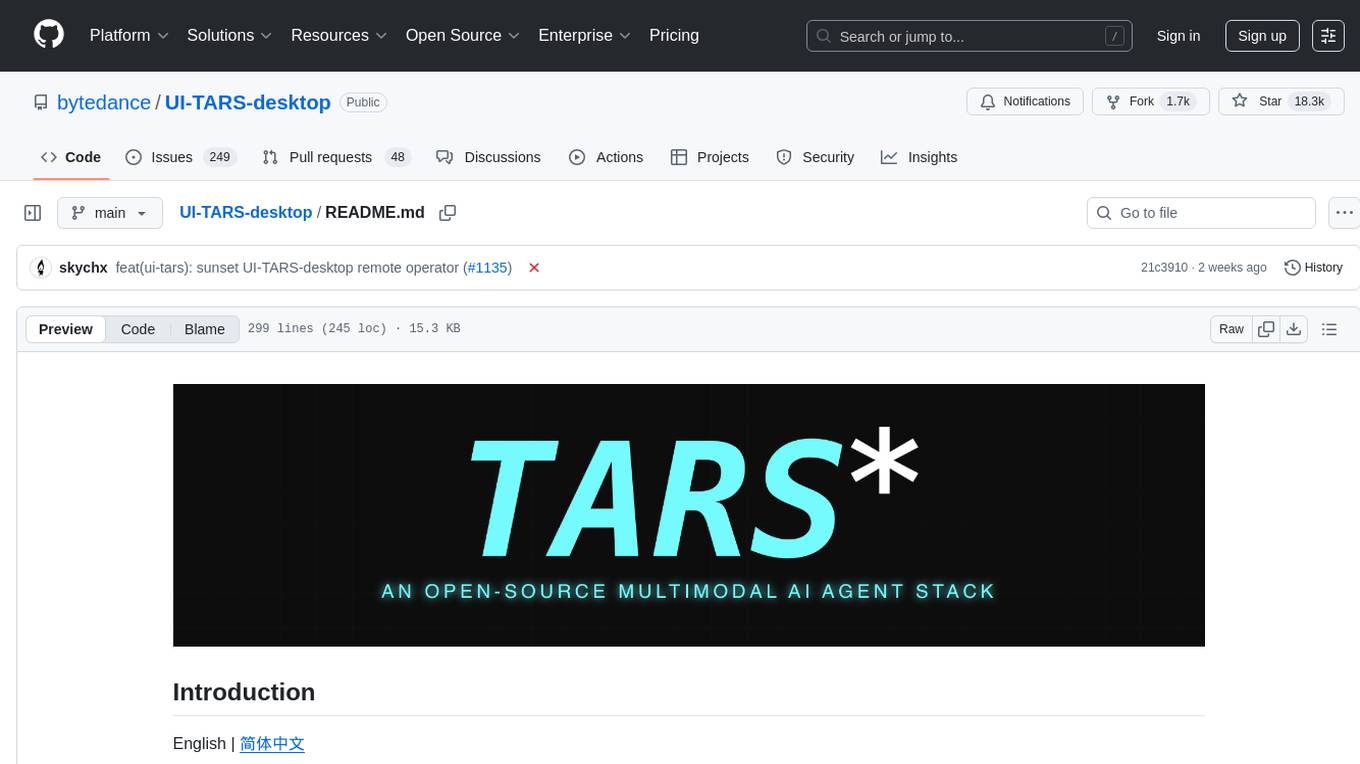
UI-TARS-desktop
UI-TARS-desktop is a desktop application that provides a native GUI Agent based on the UI-TARS model. It offers features such as natural language control powered by Vision-Language Model, screenshot and visual recognition support, precise mouse and keyboard control, cross-platform support (Windows/MacOS/Browser), real-time feedback and status display, and private and secure fully local processing. The application aims to enhance the user's computer experience, introduce new browser operation features, and support the advanced UI-TARS-1.5 model for improved performance and precise control.
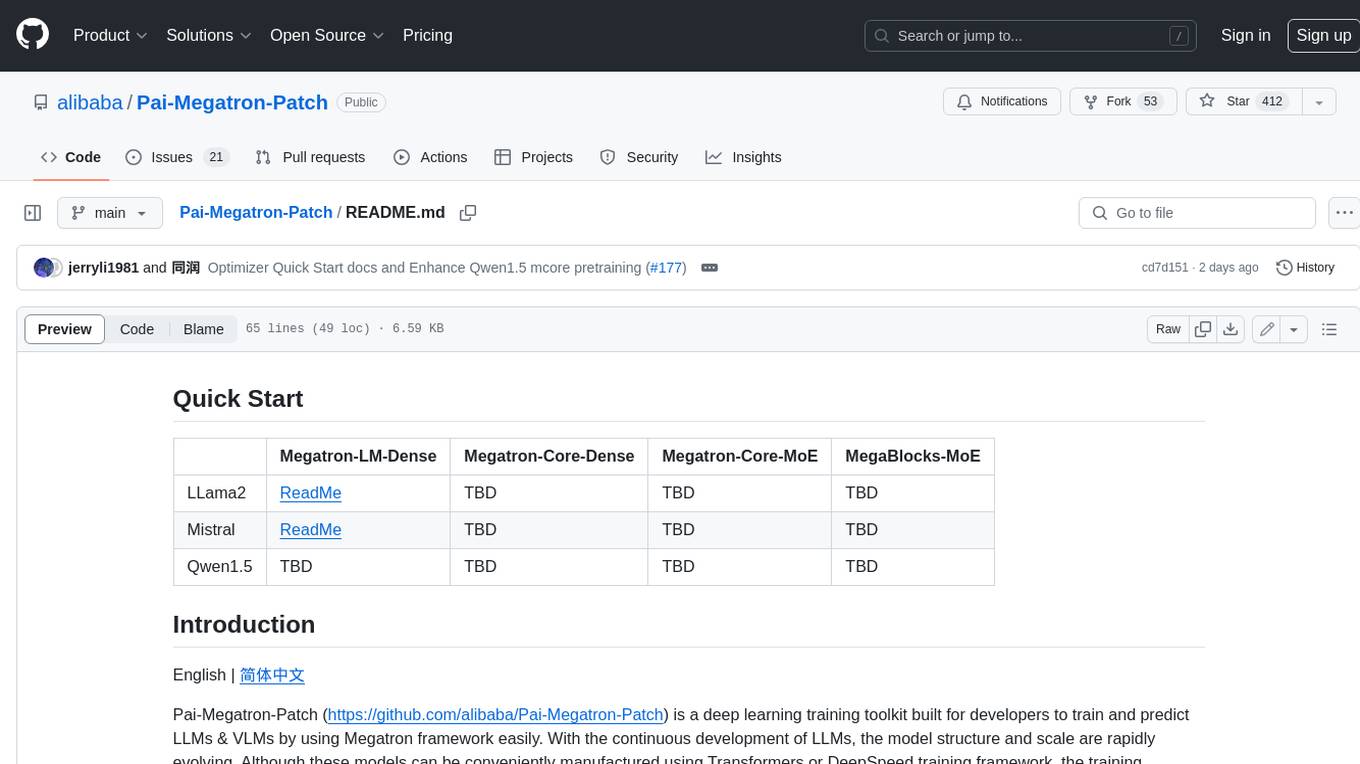
Pai-Megatron-Patch
Pai-Megatron-Patch is a deep learning training toolkit built for developers to train and predict LLMs & VLMs by using Megatron framework easily. With the continuous development of LLMs, the model structure and scale are rapidly evolving. Although these models can be conveniently manufactured using Transformers or DeepSpeed training framework, the training efficiency is comparably low. This phenomenon becomes even severer when the model scale exceeds 10 billion. The primary objective of Pai-Megatron-Patch is to effectively utilize the computational power of GPUs for LLM. This tool allows convenient training of commonly used LLM with all the accelerating techniques provided by Megatron-LM.
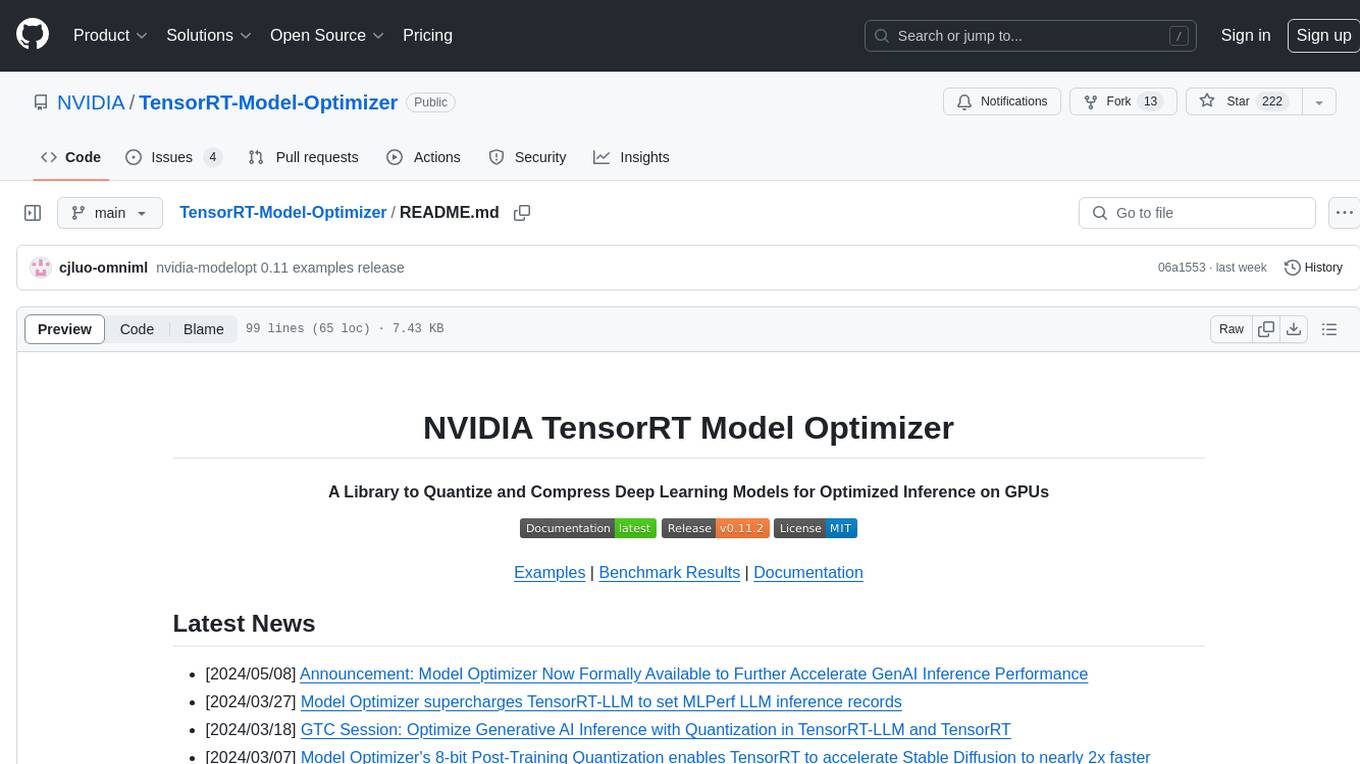
TensorRT-Model-Optimizer
The NVIDIA TensorRT Model Optimizer is a library designed to quantize and compress deep learning models for optimized inference on GPUs. It offers state-of-the-art model optimization techniques including quantization and sparsity to reduce inference costs for generative AI models. Users can easily stack different optimization techniques to produce quantized checkpoints from torch or ONNX models. The quantized checkpoints are ready for deployment in inference frameworks like TensorRT-LLM or TensorRT, with planned integrations for NVIDIA NeMo and Megatron-LM. The tool also supports 8-bit quantization with Stable Diffusion for enterprise users on NVIDIA NIM. Model Optimizer is available for free on NVIDIA PyPI, and this repository serves as a platform for sharing examples, GPU-optimized recipes, and collecting community feedback.
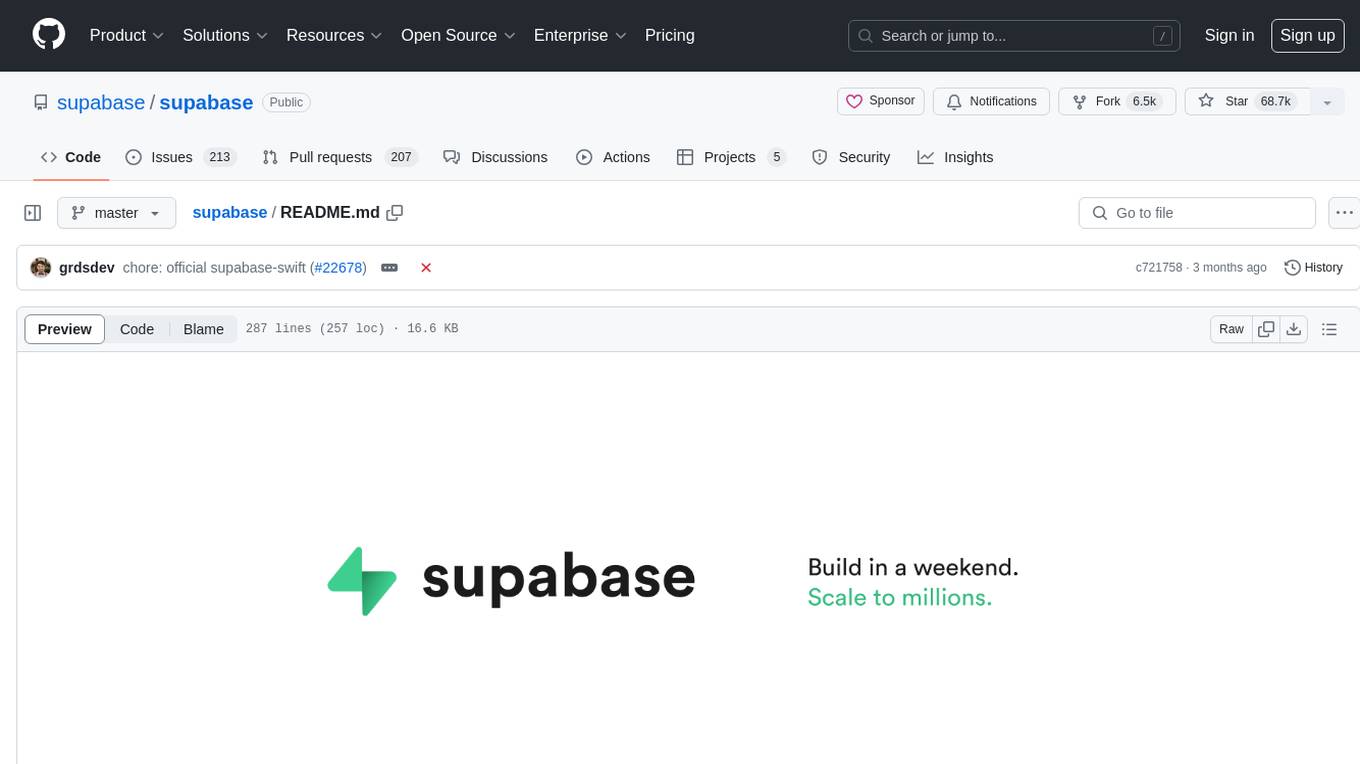
supabase
Supabase is an open source Firebase alternative that provides a wide range of features including a hosted Postgres database, authentication and authorization, auto-generated APIs, REST and GraphQL support, realtime subscriptions, functions, file storage, AI and vector/embeddings toolkit, and a dashboard. It aims to offer developers a Firebase-like experience using enterprise-grade open source tools.
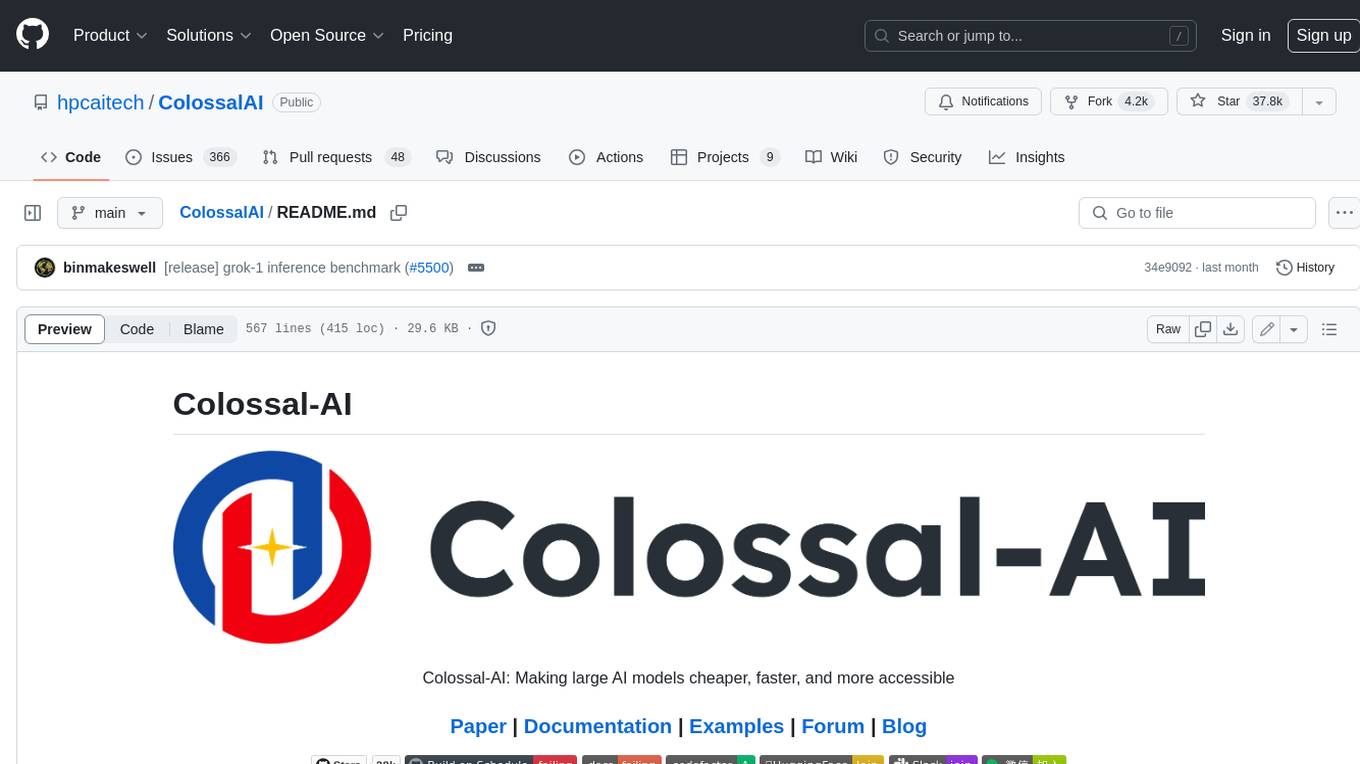
ColossalAI
Colossal-AI is a deep learning system for large-scale parallel training. It provides a unified interface to scale sequential code of model training to distributed environments. Colossal-AI supports parallel training methods such as data, pipeline, tensor, and sequence parallelism and is integrated with heterogeneous training and zero redundancy optimizer.
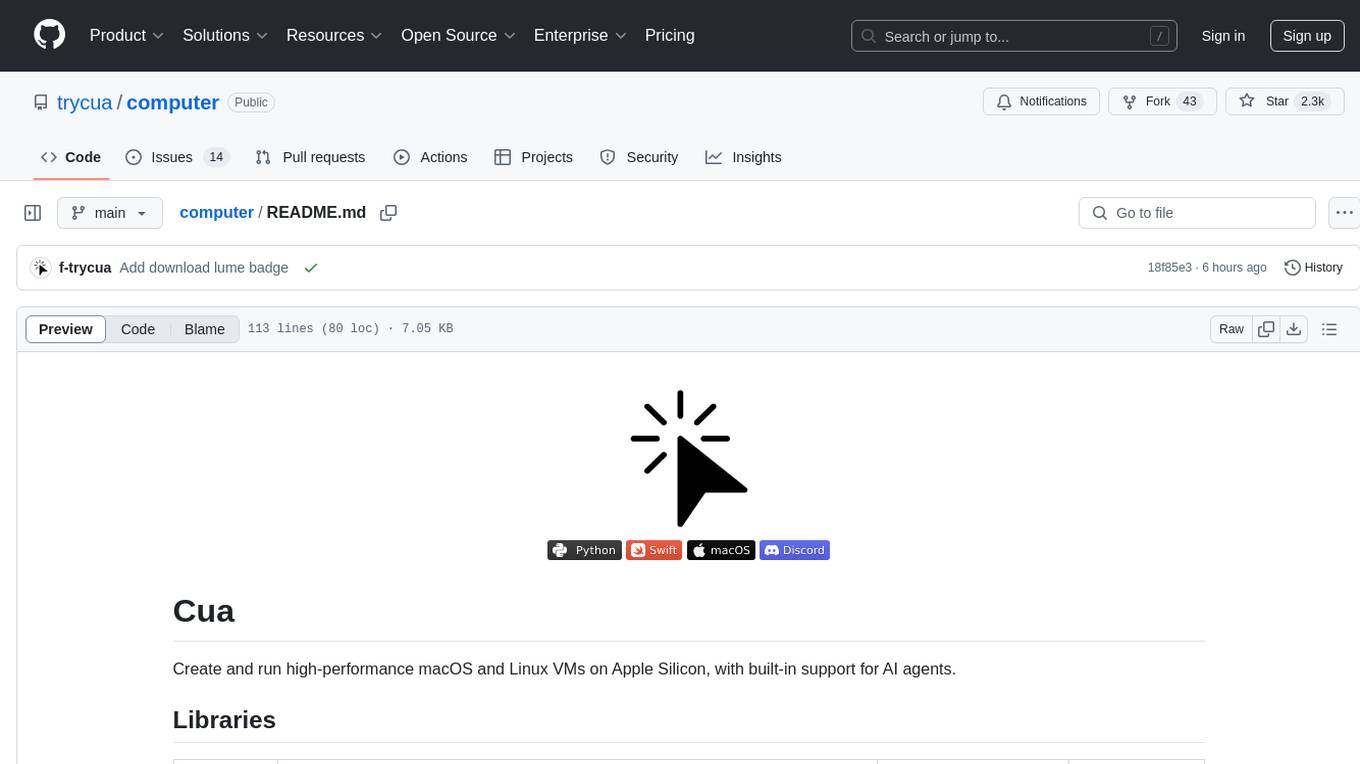
computer
Cua is a tool for creating and running high-performance macOS and Linux VMs on Apple Silicon, with built-in support for AI agents. It provides libraries like Lume for running VMs with near-native performance, Computer for interacting with sandboxes, and Agent for running agentic workflows. Users can refer to the documentation for onboarding and explore demos showcasing the tool's capabilities. Additionally, accessory libraries like Core, PyLume, Computer Server, and SOM offer additional functionality. Contributions to Cua are welcome, and the tool is open-sourced under the MIT License.
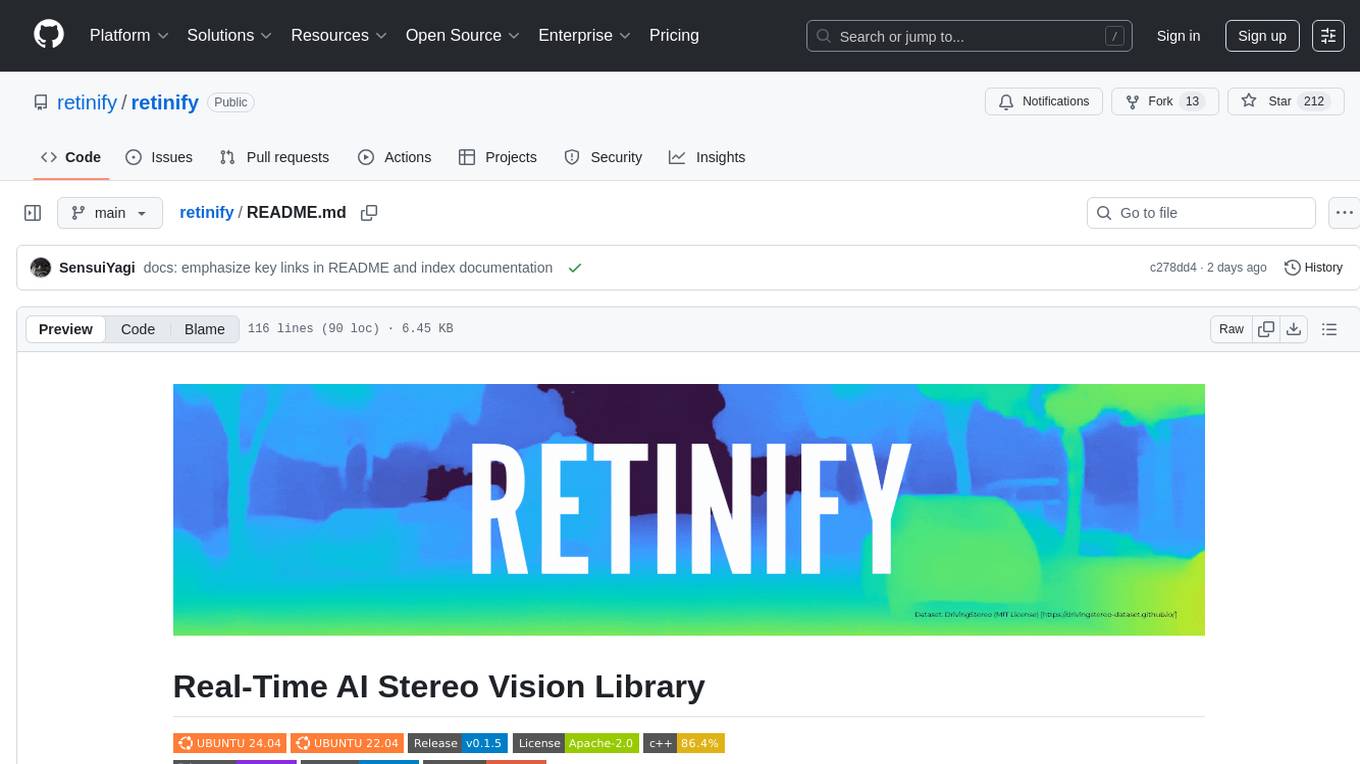
retinify
Retinify is an advanced AI-powered stereo vision library designed for robotics, enabling real-time, high-precision 3D perception by leveraging GPU and NPU acceleration. It is open source under Apache-2.0 license, offers high precision 3D mapping and object recognition, runs computations on GPU for fast performance, accepts stereo images from any rectified camera setup, is cost-efficient using minimal hardware, and has minimal dependencies on CUDA Toolkit, cuDNN, and TensorRT. The tool provides a pipeline for stereo matching and supports various image data types independently of OpenCV.
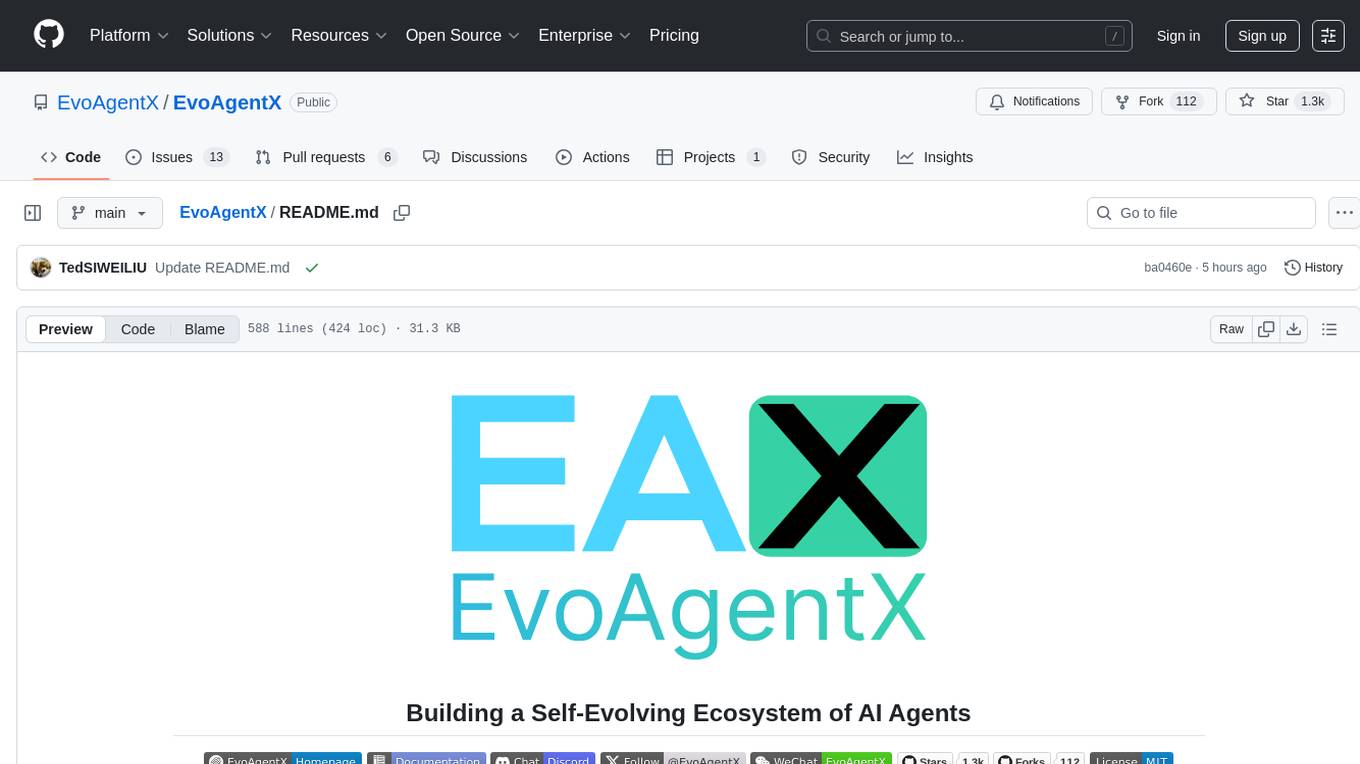
EvoAgentX
EvoAgentX is an open-source framework for building, evaluating, and evolving LLM-based agents or agentic workflows in an automated, modular, and goal-driven manner. It enables developers and researchers to move beyond static prompt chaining or manual workflow orchestration by introducing a self-evolving agent ecosystem. The framework includes features such as agent workflow autoconstruction, built-in evaluation, self-evolution engine, plug-and-play compatibility, comprehensive built-in tools, memory module support, and human-in-the-loop interactions.
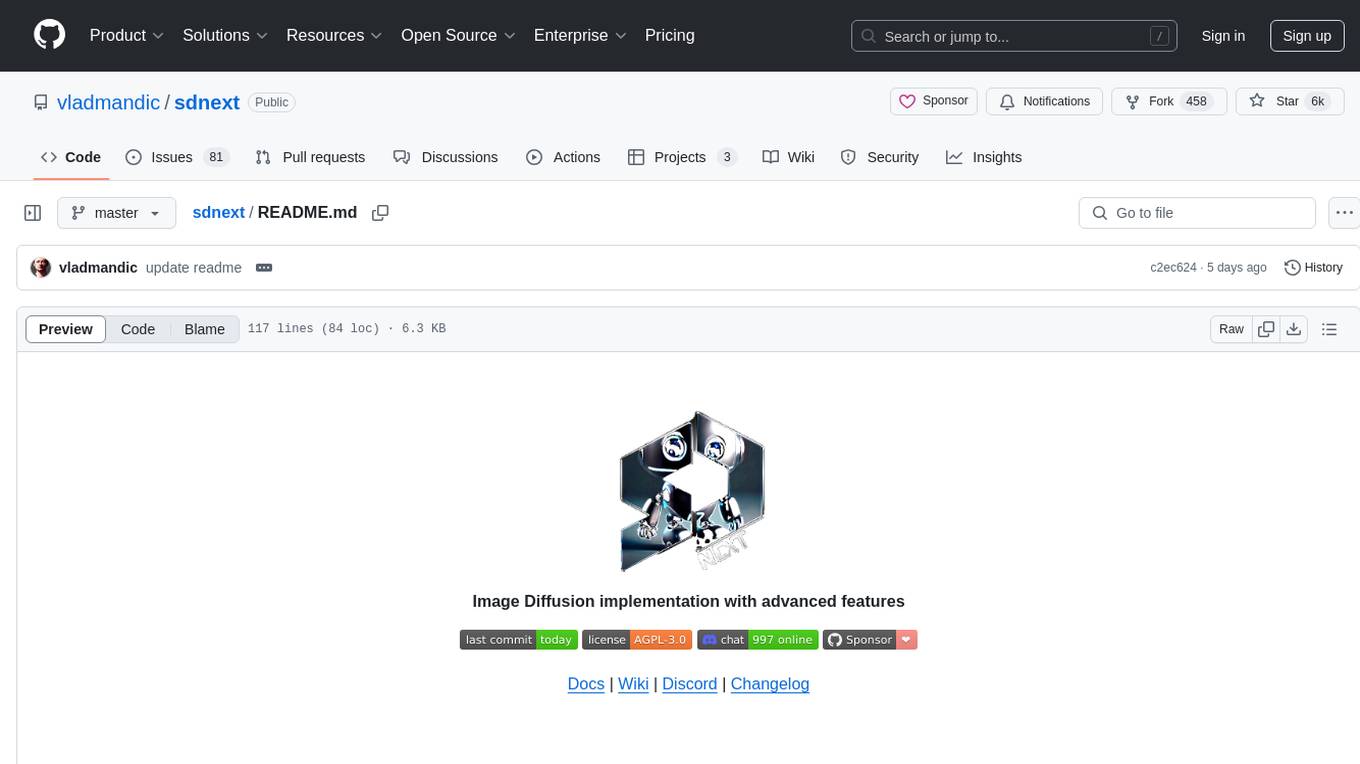
sdnext
SD.Next is an Image Diffusion implementation with advanced features. It offers multiple UI options, diffusion models, and built-in controls for text, image, batch, and video processing. The tool is multiplatform, supporting Windows, Linux, MacOS, nVidia, AMD, IntelArc/IPEX, DirectML, OpenVINO, ONNX+Olive, and ZLUDA. It provides optimized processing with the latest torch developments, including model compile, quantize, and compress functionalities. SD.Next also features Interrogate/Captioning with various models, queue management, automatic updates, and mobile compatibility.
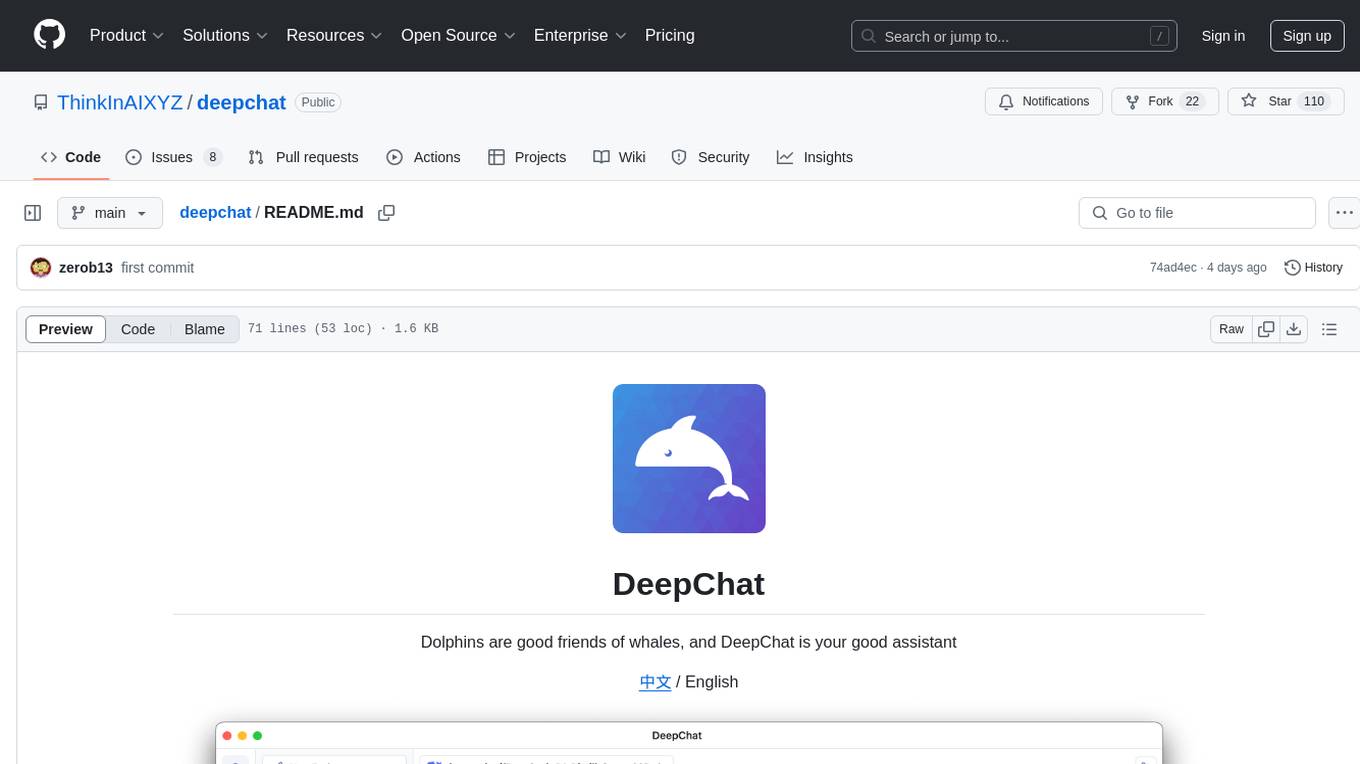
deepchat
DeepChat is a versatile chat tool that supports multiple model cloud services and local model deployment. It offers multi-channel chat concurrency support, platform compatibility, complete Markdown rendering, and easy usability with a comprehensive guide. The tool aims to enhance chat experiences by leveraging various AI models and ensuring efficient conversation management.
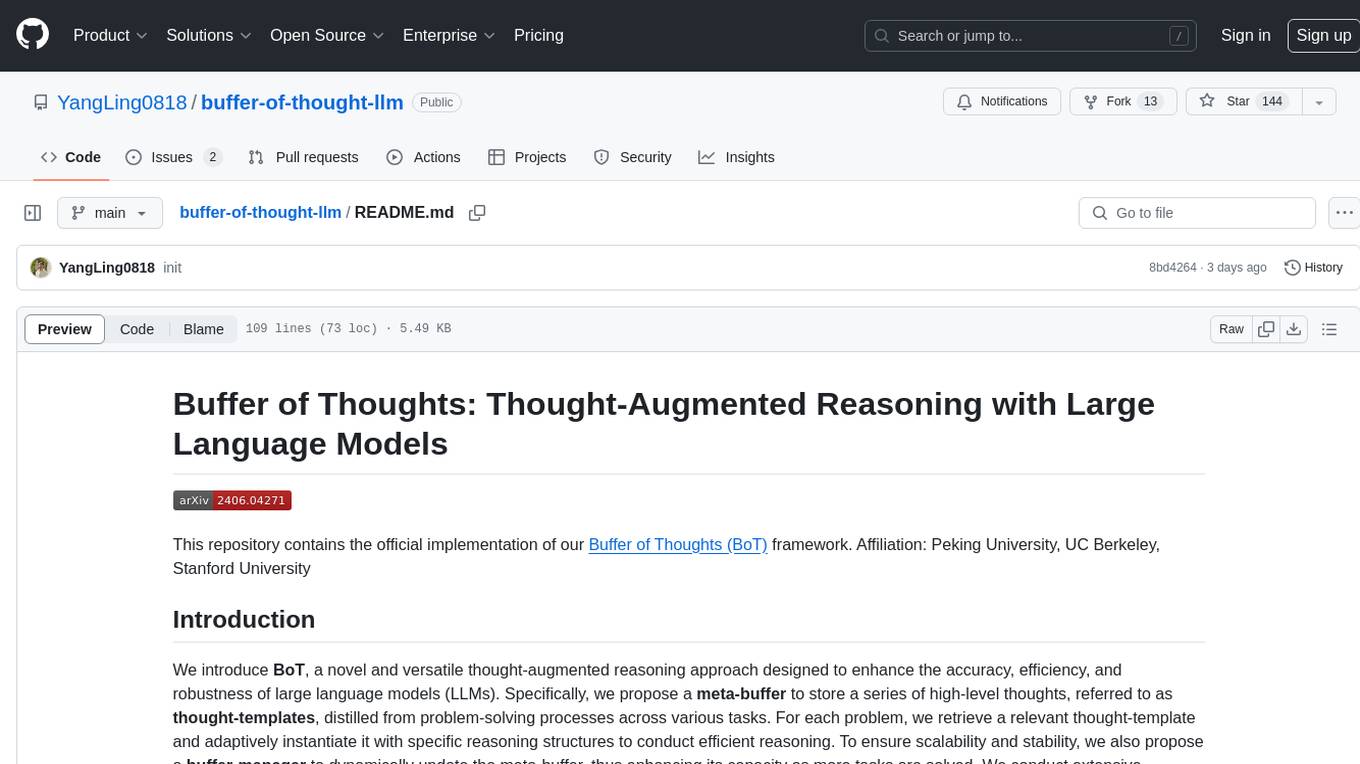
buffer-of-thought-llm
Buffer of Thoughts (BoT) is a thought-augmented reasoning framework designed to enhance the accuracy, efficiency, and robustness of large language models (LLMs). It introduces a meta-buffer to store high-level thought-templates distilled from problem-solving processes, enabling adaptive reasoning for efficient problem-solving. The framework includes a buffer-manager to dynamically update the meta-buffer, ensuring scalability and stability. BoT achieves significant performance improvements on reasoning-intensive tasks and demonstrates superior generalization ability and robustness while being cost-effective compared to other methods.
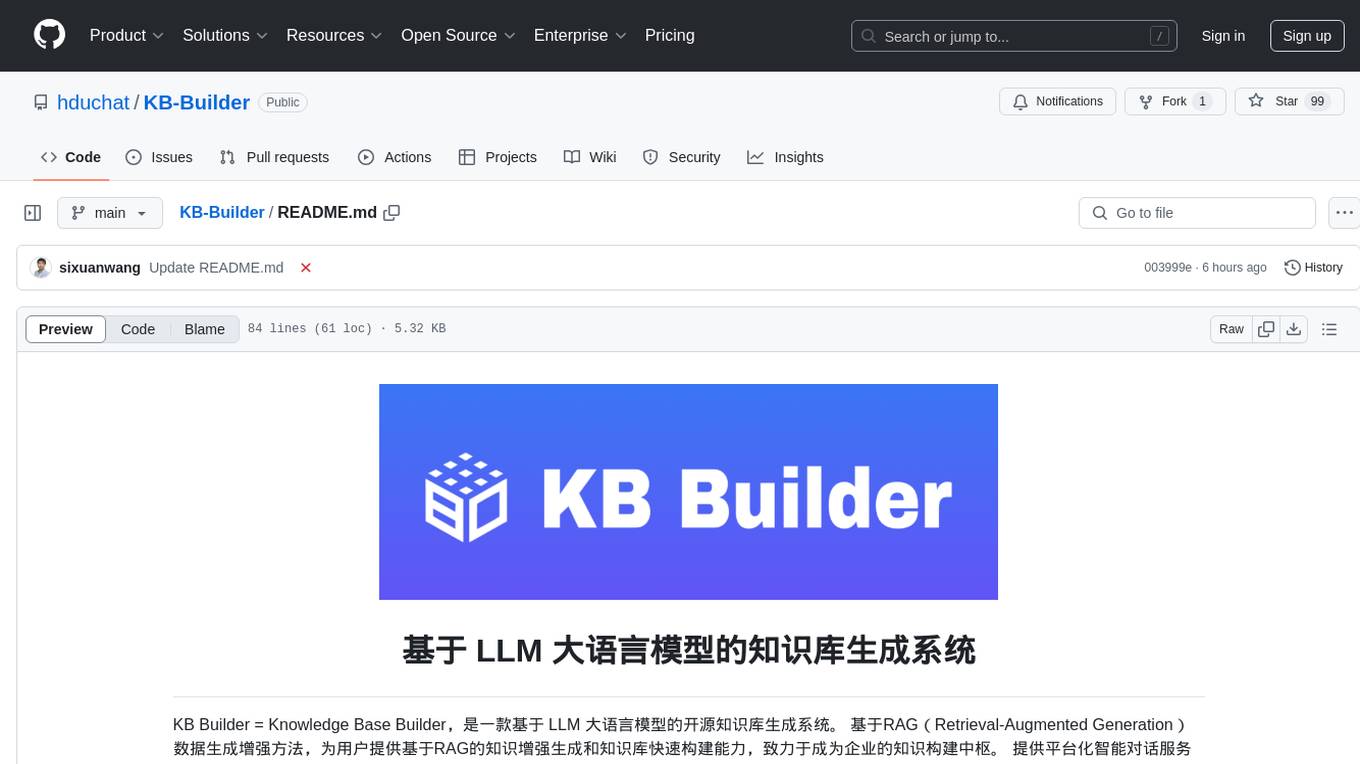
KB-Builder
KB Builder is an open-source knowledge base generation system based on the LLM large language model. It utilizes the RAG (Retrieval-Augmented Generation) data generation enhancement method to provide users with the ability to enhance knowledge generation and quickly build knowledge bases based on RAG. It aims to be the central hub for knowledge construction in enterprises, offering platform-based intelligent dialogue services and document knowledge base management functionality. Users can upload docx, pdf, txt, and md format documents and generate high-quality knowledge base question-answer pairs by invoking large models through the 'Parse Document' feature.
For similar tasks

RLinf
RLinf is a flexible and scalable open-source infrastructure designed for post-training foundation models via reinforcement learning. It provides a robust backbone for next-generation training, supporting open-ended learning, continuous generalization, and limitless possibilities in intelligence development. The tool offers unique features like Macro-to-Micro Flow, flexible execution modes, auto-scheduling strategy, embodied agent support, and fast adaptation for mainstream VLA models. RLinf is fast with hybrid mode and automatic online scaling strategy, achieving significant throughput improvement and efficiency. It is also flexible and easy to use with multiple backend integrations, adaptive communication, and built-in support for popular RL methods. The roadmap includes system-level enhancements and application-level extensions to support various training scenarios and models. Users can get started with complete documentation, quickstart guides, key design principles, example gallery, advanced features, and guidelines for extending the framework. Contributions are welcome, and users are encouraged to cite the GitHub repository and acknowledge the broader open-source community.

spear
SPEAR (Simulator for Photorealistic Embodied AI Research) is a powerful tool for training embodied agents. It features 300 unique virtual indoor environments with 2,566 unique rooms and 17,234 unique objects that can be manipulated individually. Each environment is designed by a professional artist and features detailed geometry, photorealistic materials, and a unique floor plan and object layout. SPEAR is implemented as Unreal Engine assets and provides an OpenAI Gym interface for interacting with the environments via Python.
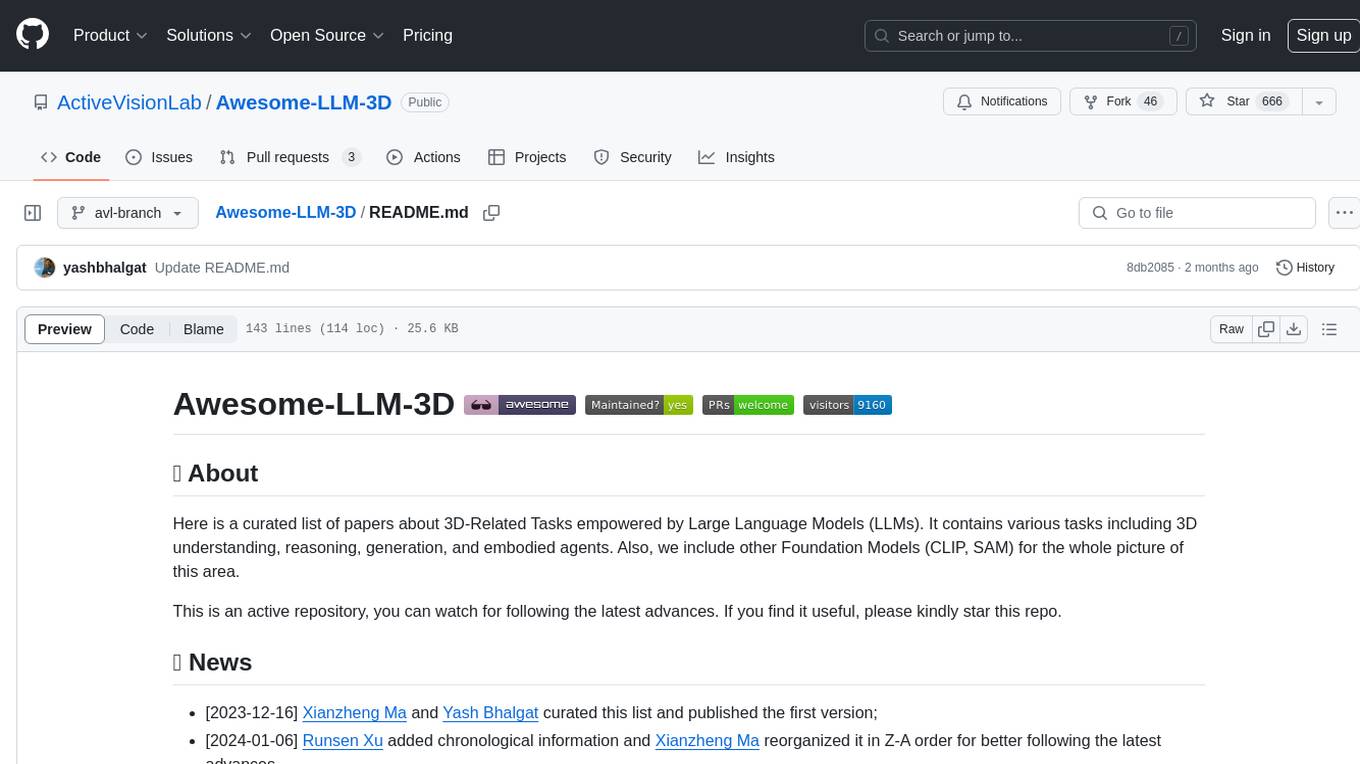
Awesome-LLM-3D
This repository is a curated list of papers related to 3D tasks empowered by Large Language Models (LLMs). It covers tasks such as 3D understanding, reasoning, generation, and embodied agents. The repository also includes other Foundation Models like CLIP and SAM to provide a comprehensive view of the area. It is actively maintained and updated to showcase the latest advances in the field. Users can find a variety of research papers and projects related to 3D tasks and LLMs in this repository.
For similar jobs

RLinf
RLinf is a flexible and scalable open-source infrastructure designed for post-training foundation models via reinforcement learning. It provides a robust backbone for next-generation training, supporting open-ended learning, continuous generalization, and limitless possibilities in intelligence development. The tool offers unique features like Macro-to-Micro Flow, flexible execution modes, auto-scheduling strategy, embodied agent support, and fast adaptation for mainstream VLA models. RLinf is fast with hybrid mode and automatic online scaling strategy, achieving significant throughput improvement and efficiency. It is also flexible and easy to use with multiple backend integrations, adaptive communication, and built-in support for popular RL methods. The roadmap includes system-level enhancements and application-level extensions to support various training scenarios and models. Users can get started with complete documentation, quickstart guides, key design principles, example gallery, advanced features, and guidelines for extending the framework. Contributions are welcome, and users are encouraged to cite the GitHub repository and acknowledge the broader open-source community.
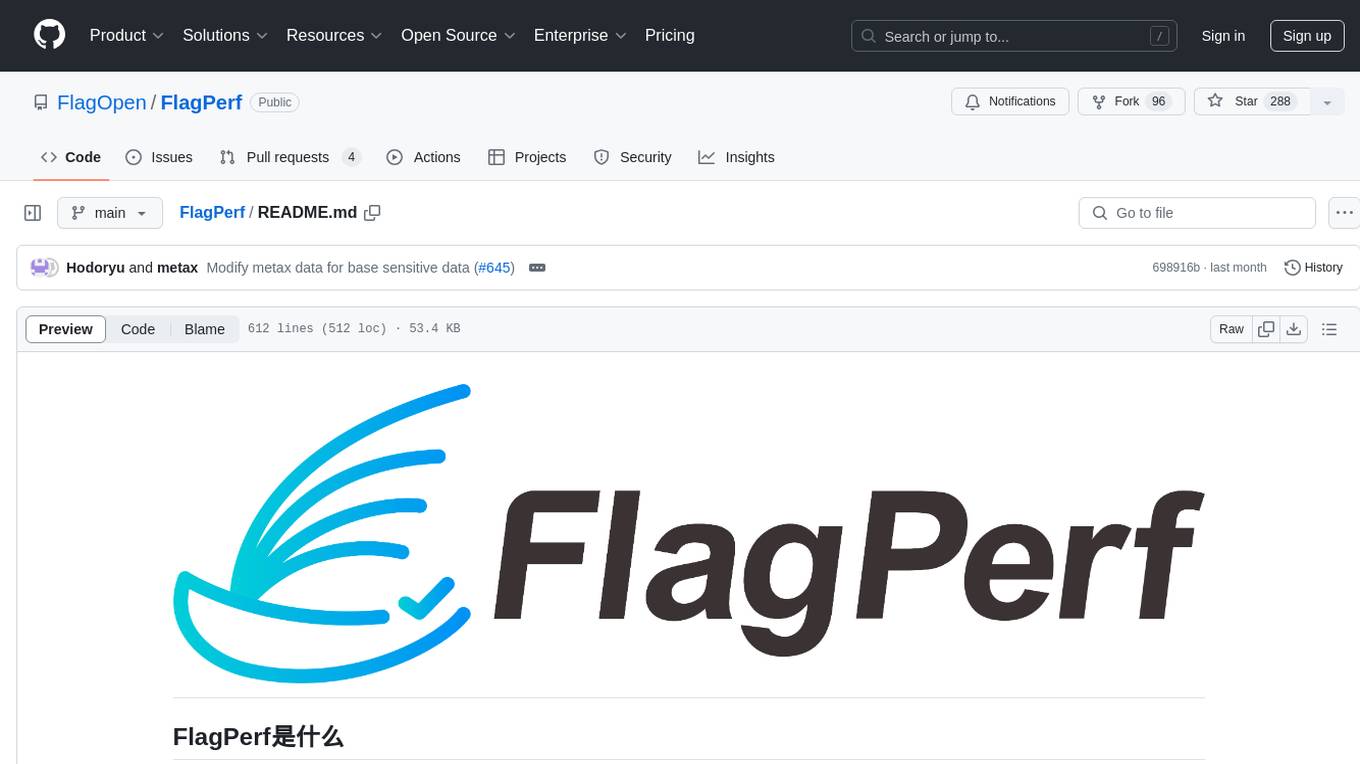
FlagPerf
FlagPerf is an integrated AI hardware evaluation engine jointly built by the Institute of Intelligence and AI hardware manufacturers. It aims to establish an industry-oriented metric system to evaluate the actual capabilities of AI hardware under software stack combinations (model + framework + compiler). FlagPerf features a multidimensional evaluation metric system that goes beyond just measuring 'whether the chip can support specific model training.' It covers various scenarios and tasks, including computer vision, natural language processing, speech, multimodal, with support for multiple training frameworks and inference engines to connect AI hardware with software ecosystems. It also supports various testing environments to comprehensively assess the performance of domestic AI chips in different scenarios.
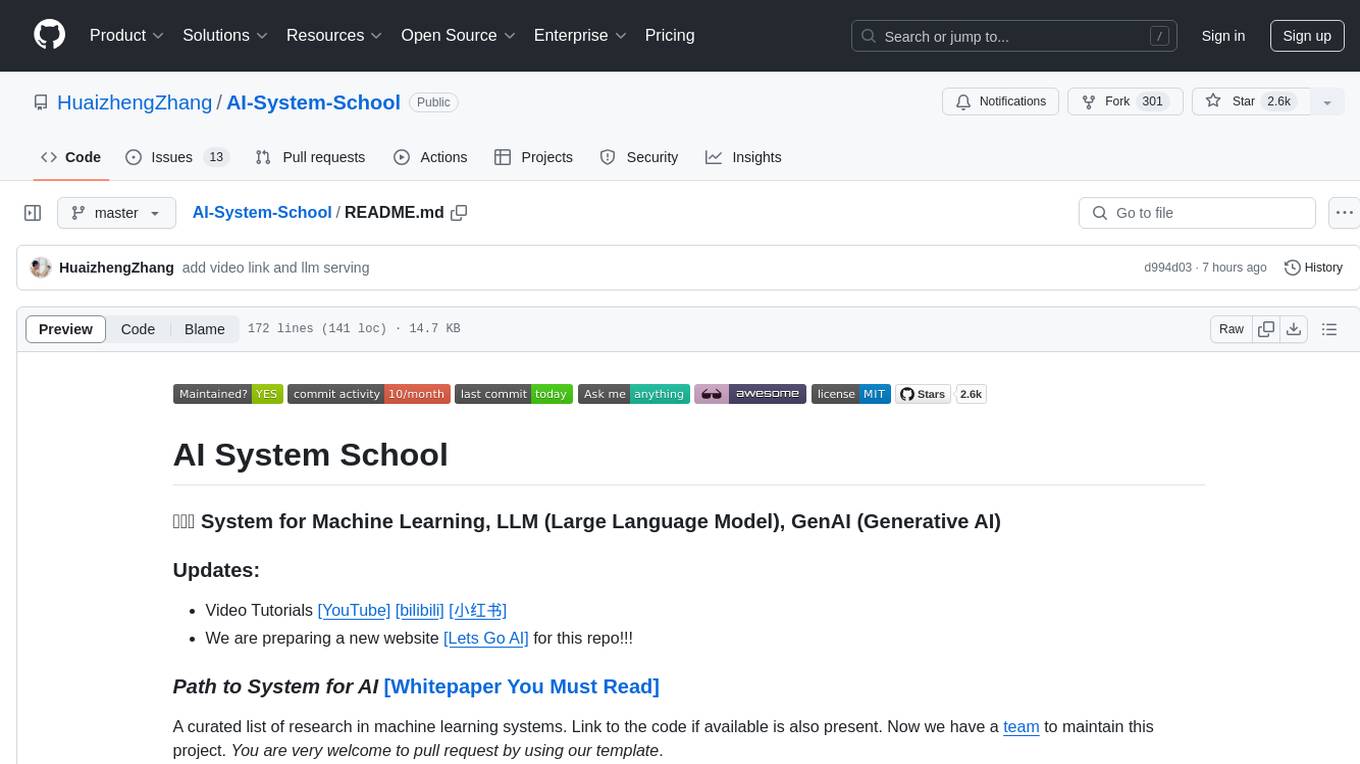
AI-System-School
AI System School is a curated list of research in machine learning systems, focusing on ML/DL infra, LLM infra, domain-specific infra, ML/LLM conferences, and general resources. It provides resources such as data processing, training systems, video systems, autoML systems, and more. The repository aims to help users navigate the landscape of AI systems and machine learning infrastructure, offering insights into conferences, surveys, books, videos, courses, and blogs related to the field.
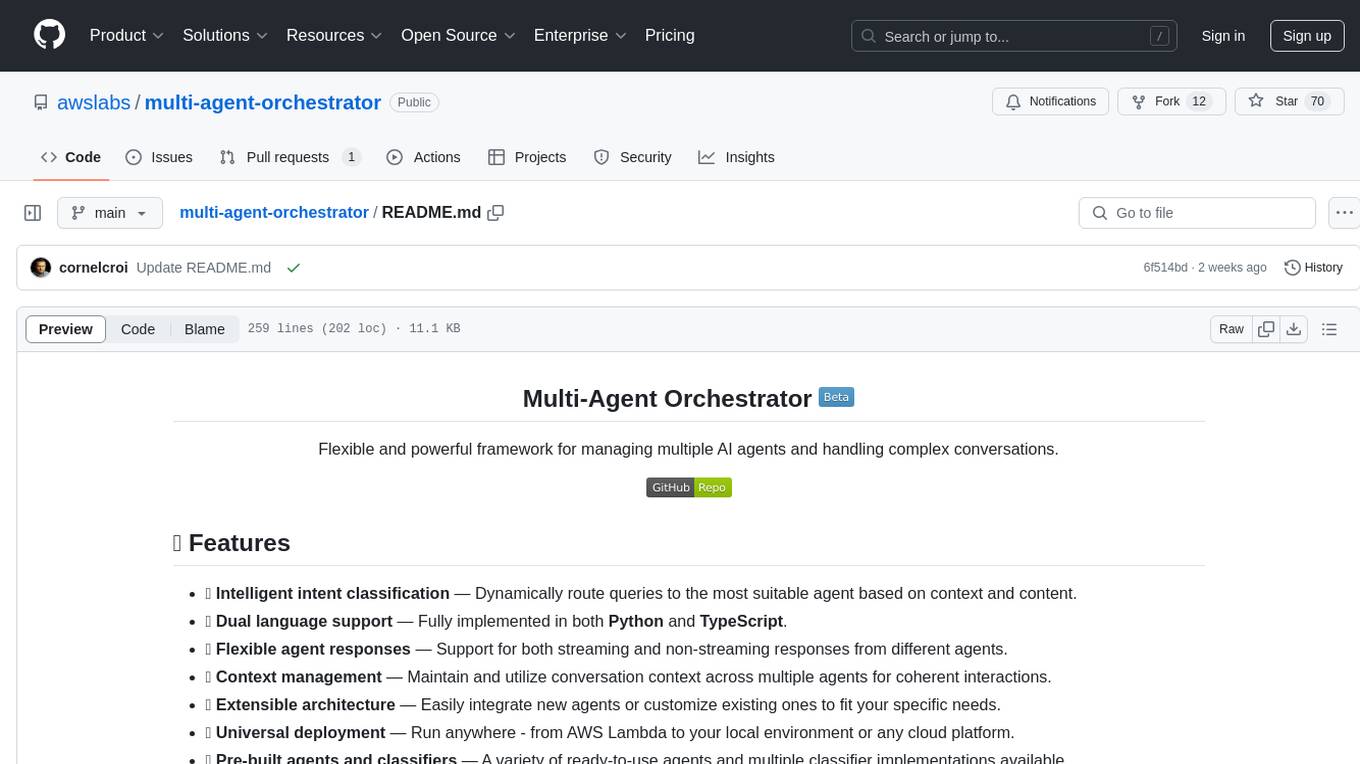
multi-agent-orchestrator
Multi-Agent Orchestrator is a flexible and powerful framework for managing multiple AI agents and handling complex conversations. It intelligently routes queries to the most suitable agent based on context and content, supports dual language implementation in Python and TypeScript, offers flexible agent responses, context management across agents, extensible architecture for customization, universal deployment options, and pre-built agents and classifiers. It is suitable for various applications, from simple chatbots to sophisticated AI systems, accommodating diverse requirements and scaling efficiently.
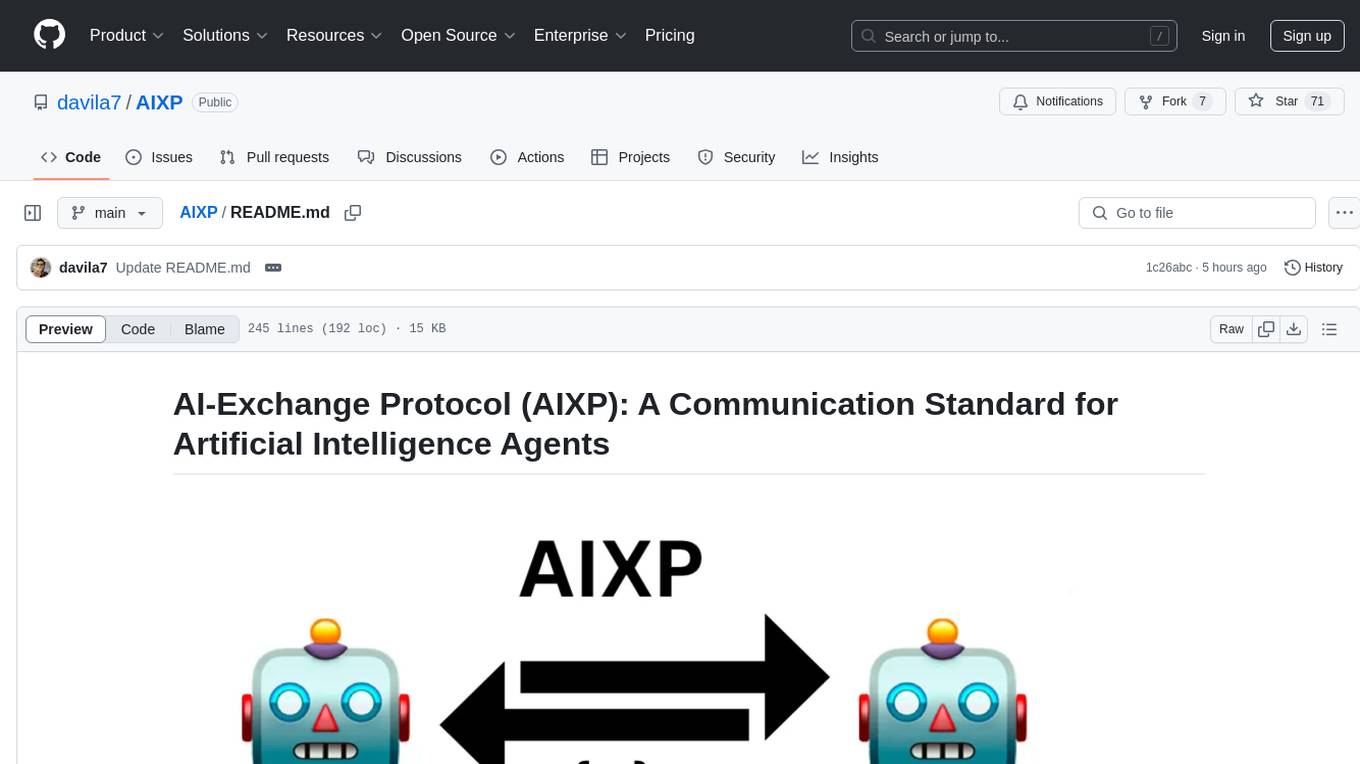
AIXP
The AI-Exchange Protocol (AIXP) is a communication standard designed to facilitate information and result exchange between artificial intelligence agents. It aims to enhance interoperability and collaboration among various AI systems by establishing a common framework for communication. AIXP includes components for communication, loop prevention, and task finalization, ensuring secure and efficient collaboration while avoiding infinite communication loops. The protocol defines access points, data formats, authentication, authorization, versioning, loop detection, status codes, error messages, and task completion verification. AIXP enables AI agents to collaborate seamlessly and complete tasks effectively, contributing to the overall efficiency and reliability of AI systems.
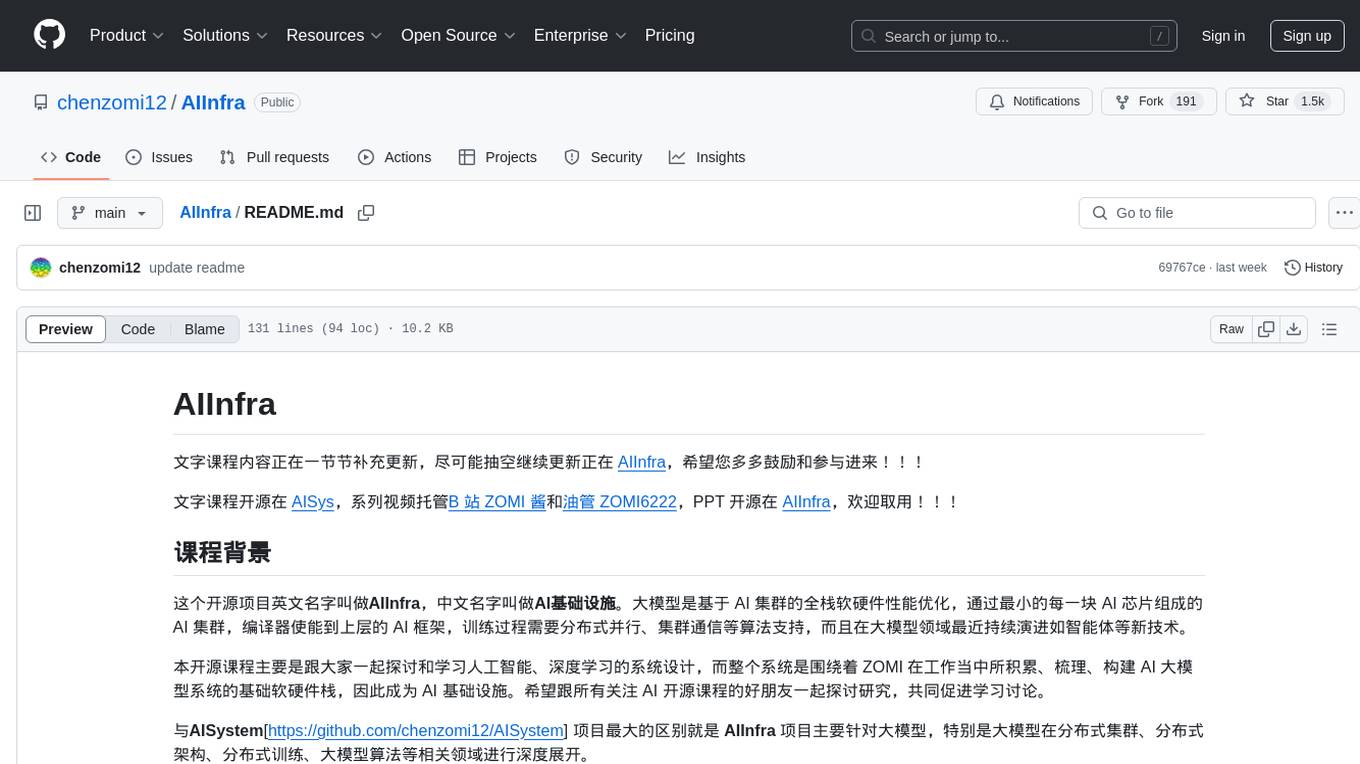
AIInfra
AIInfra is an open-source project focused on AI infrastructure, specifically targeting large models in distributed clusters, distributed architecture, distributed training, and algorithms related to large models. The project aims to explore and study system design in artificial intelligence and deep learning, with a focus on the hardware and software stack for building AI large model systems. It provides a comprehensive curriculum covering topics such as AI chip principles, communication and storage, AI clusters, large model training, and inference, as well as algorithms for large models. The course is designed for undergraduate and graduate students, as well as professionals working with AI large model systems, to gain a deep understanding of AI computer system architecture and design.
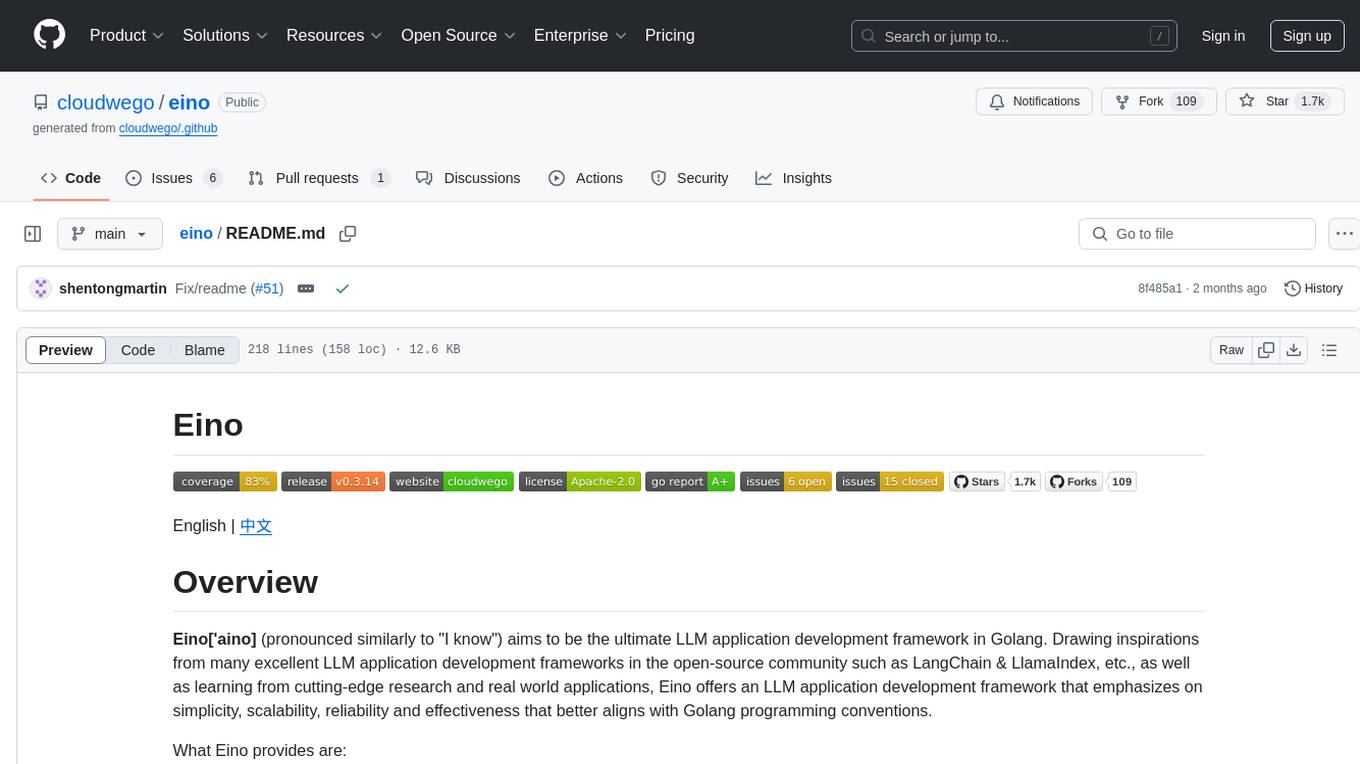
eino
Eino is an ultimate LLM application development framework in Golang, emphasizing simplicity, scalability, reliability, and effectiveness. It provides a curated list of component abstractions, a powerful composition framework, meticulously designed APIs, best practices, and tools covering the entire development cycle. Eino standardizes and improves efficiency in AI application development by offering rich components, powerful orchestration, complete stream processing, highly extensible aspects, and a comprehensive framework structure.
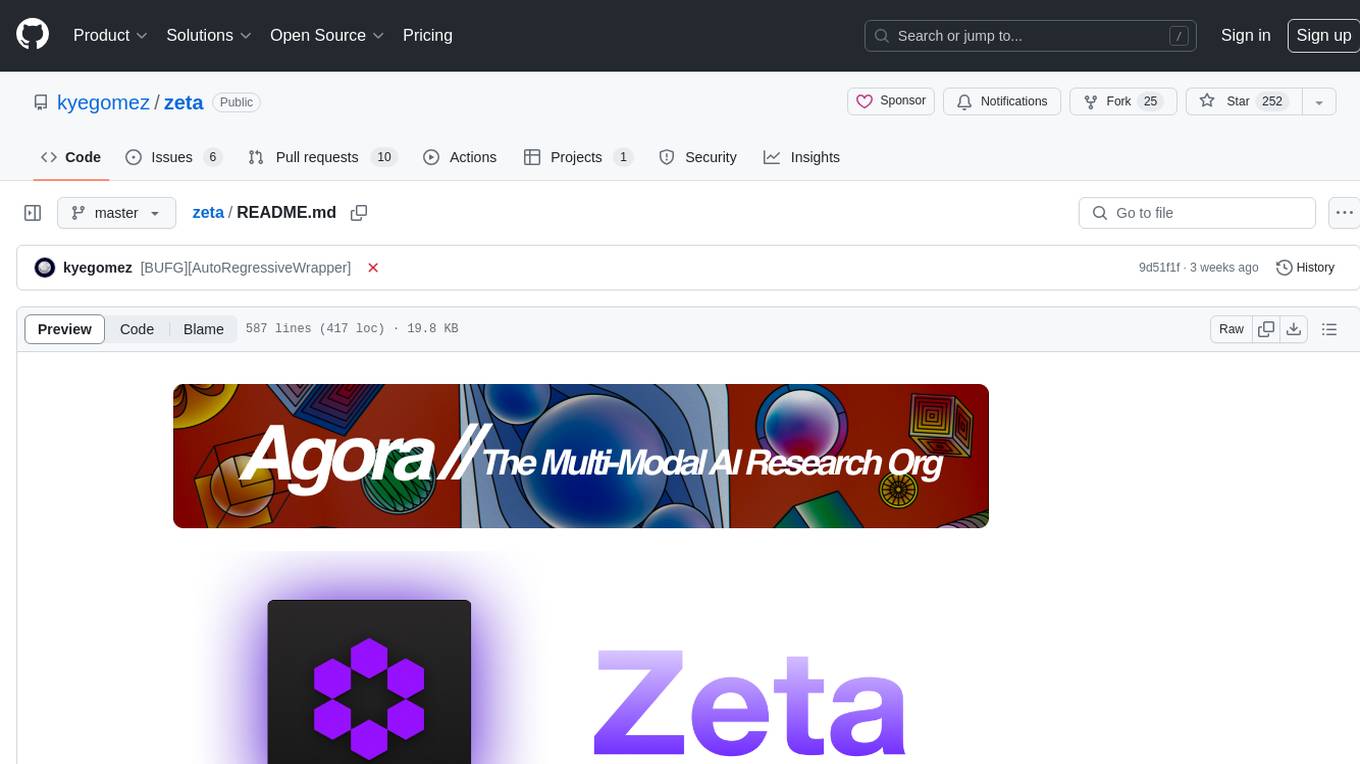
zeta
Zeta is a tool designed to build state-of-the-art AI models faster by providing modular, high-performance, and scalable building blocks. It addresses the common issues faced while working with neural nets, such as chaotic codebases, lack of modularity, and low performance modules. Zeta emphasizes usability, modularity, and performance, and is currently used in hundreds of models across various GitHub repositories. It enables users to prototype, train, optimize, and deploy the latest SOTA neural nets into production. The tool offers various modules like FlashAttention, SwiGLUStacked, RelativePositionBias, FeedForward, BitLinear, PalmE, Unet, VisionEmbeddings, niva, FusedDenseGELUDense, FusedDropoutLayerNorm, MambaBlock, Film, hyper_optimize, DPO, and ZetaCloud for different tasks in AI model development.





